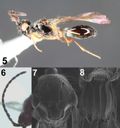Carpomyini
Carpomyini
Classification
- Phylum: Arthropoda
- Subphylum: Hexapoda
- Class: Insecta
- Order: Diptera
- Superfamily: Tephritoidea
- Family: Tephritidae
- Subfamily: Trypetinae
- Tribe: Carpomyini
Pronunciation
How to pronounce Carpomyini: //ˌkɑːrpoʊˈmaɪ.ɪ.naɪ//
These audio files are automatically generated. While they are not always 100% accurate, they are a good starting point.
Images






Summary
The Carpomyini tribe encompasses a diverse group of fruit flies, primarily found in North and South America, with significant ecological roles in pollination and fruit decomposition.
Physical Characteristics
Small to medium-sized fruit flies with distinctive wing patterns; coloration varies by species.
Identification Tips
Identification can be aided by examining wing patterns and coloration, as well as size and body shape.
Habitat
Primarily found in wooded and shrubby areas where host plants are available.
Distribution
Approximately 40 species in 6 genera in the region, with more than 120 species across 12 genera worldwide; predominant in the New World.
Diet
Adults primarily feed on nectar from flowers, while larvae typically develop in the fruits of host plants.
Life Cycle
Life cycle includes egg, larval, pupal, and adult stages.
Reproduction
Females lay eggs in ripe or developing fruits, where larvae then feed until they mature.
Predators
Natural predators include various birds, insects, and other arthropods that feed on adult flies or larvae.
Ecosystem Role
Act as pollinators while adults feed on nectar; larvae contribute to the decomposition of fruit.
Economic Impact
Some species can be pests of agricultural crops, particularly fruit plants, impacting yield and quality.
Collecting Methods
- Trap with bait designed for fruit flies
- Manual collection from host plants
Preservation Methods
- Ethanol preservation
- Freezing for short-term storage
Evolution
Evolved within the Tephritidae family, showing adaptations to fruit feeding and mimicry to avoid predation.
Similar Taxa
- Other tephritid flies
- Fruit flies in the family Tephritidae
Misconceptions
Often confused with other types of flies, particularly house flies; not all fruit flies are pests.
Tags
- Carpomyini
- Zonosemata
- fruit flies
- tephritid
- insects
- North America
- South America